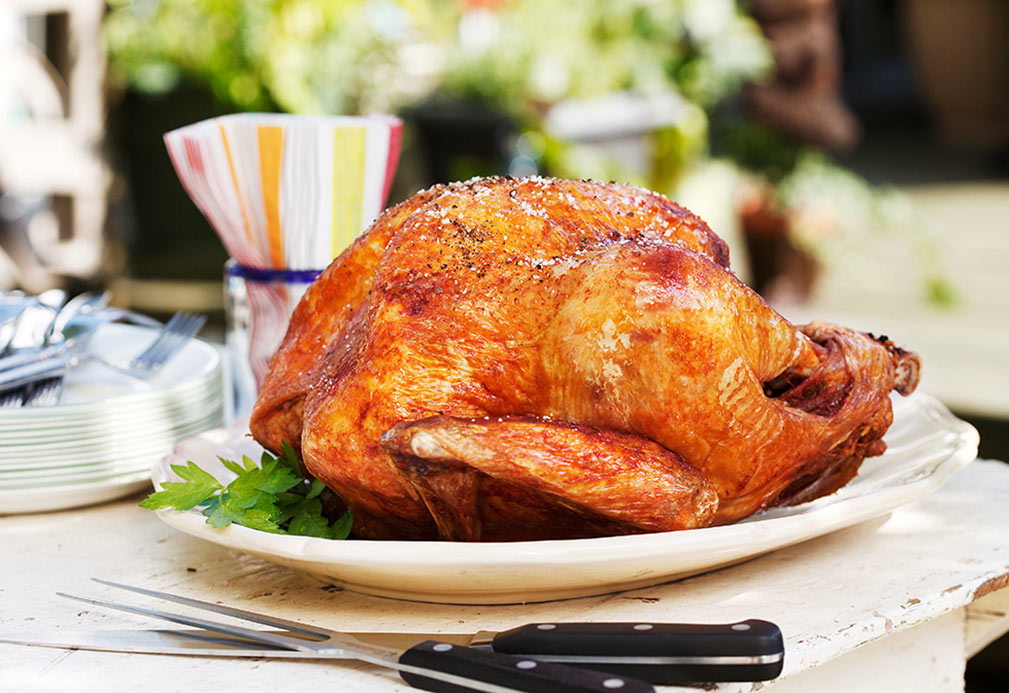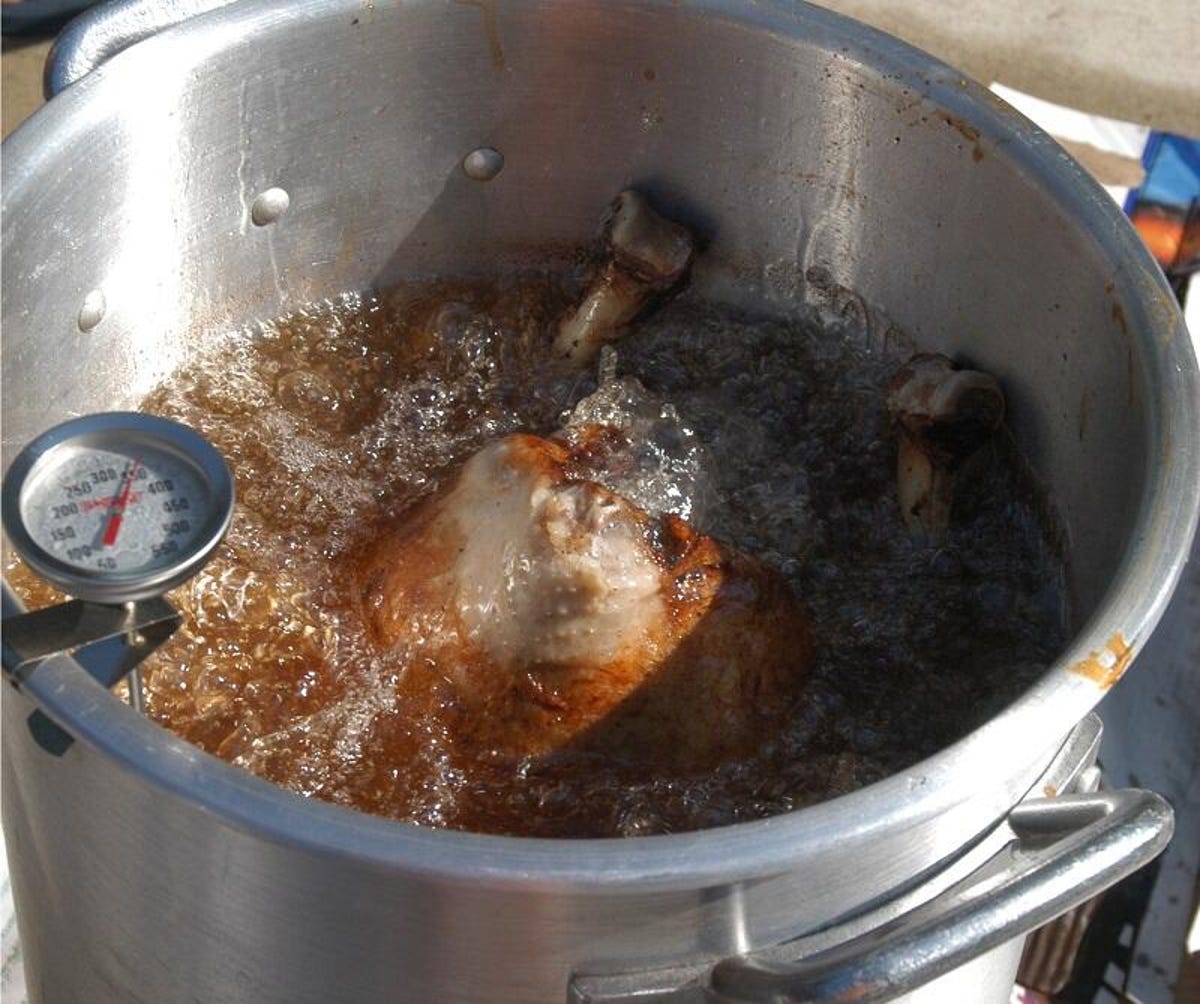Courting disaster is worth it for something this delicious — but safety is of paramount importance.
Deep-frying makes everything taste good, including Thanksgiving turkey. But frying a turkey is a serious undertaking and, as countless flame-engulfed YouTube videos attest, incredibly dangerous if done wrong. So here are some tips on how to deep fry turkey — and what not to do.
Deep frying a turkey is a popular cooking method that yields a juicy crispy and flavorful bird. While peanut oil is traditionally used, canola oil is also an excellent option. Read on to learn why canola oil works well for deep frying turkey and get tips to stay safe.
Why Choose Canola Oil?
Here’s why canola oil is one of the best oils for deep frying your Thanksgiving turkey:
-
High smoke point of 400°F – This allows the oil to withstand the high heat needed to fry a turkey without burning.
-
Neutral flavor – Canola oil won’t impart its own taste, ensuring you just get juicy turkey flavor.
-
Affordable price – Canola oil is budget-friendly compared to pricier peanut oil
-
Low saturated fat – Canola contains healthy unsaturated fats instead of artery-clogging saturated fat.
-
Easy availability – You can find canola oil year-round at any grocery store.
Safety Tips for Turkey Frying
Deep frying a 10-15 lb turkey requires caution. Follow these tips for safe frying:
-
Use a turkey fryer designed for frying. Do NOT use a pot on a cooktop.
-
Fry outside on a flat surface, far from buildings or trees.
-
Don’t overfill the fryer with oil. Follow the instructions.
-
Slowly lower the turkey into hot oil to prevent splattering.
-
Monitor the oil temp and don’t let it exceed 400°F.
-
Wear gloves and long sleeves to avoid burns.
-
Turn off the flame before removing the turkey.
-
Allow the oil to fully cool before disposing or filtering.
Step-By-Step Guide to Deep Fry Turkey with Canola
Follow this simple process for crispy deep fried turkey perfection:
Prep the Turkey
-
Thaw the turkey completely and remove giblets.
-
Rinse turkey and pat dry with paper towels.
-
Rub salt, pepper and any other seasonings under and on the skin.
-
Insert a turkey fryer thermometer into the thickest part of the breast.
Heat the Oil
-
Pour canola oil into turkey fryer, leaving 6-8 inches at top.
-
Heat oil to 350-375°F. This takes 30-45 minutes.
-
Use thermometer to monitor oil temp and adjust heat as needed.
Fry the Turkey
-
Place turkey in fryer basket breast side up.
-
Slowly lower bird into hot oil using the handle.
-
Maintain oil temp between 325-350°F as it fries.
-
Cook 3-4 minutes per pound. Monitor temp.
-
Lift out when turkey breast hits 165°F. Drain excess oil.
Finish and Serve
-
Let turkey rest 20 minutes before carving.
-
Slice turkey and serve immediately for hot and crispy skin.
-
Enjoy with traditional Thanksgiving sides and gravy.
-
Filter oil after cooling and reuse up to 3 more times.
Frequently Asked Questions
Still have questions about frying turkey in canola oil? Here are some common FAQs:
Does canola oil affect the turkey’s flavor?
No, canola oil has a neutral taste that allows the flavor of the turkey and seasoning to shine.
How much oil do I need per pound of turkey?
Plan on about 1 quart of oil per pound of turkey. A 10 lb bird needs 4 gallons.
Is reused oil safe for frying?
Yes, you can reuse filtered frying oil 2-3 more times. Discard oil that smells, smokes or is dark.
What’s the ideal frying temperature range?
Heat oil to 350-375°F initially. Maintain 325-350°F when frying. Use a thermometer!
Can I fry a frozen turkey?
Absolutely not! Only fry fully thawed and dried turkeys. Ice crystals can cause hot oil to splatter.
What size propane tank do I need?
Opt for a full 20 lb propane tank. You’ll burn about a gallon of propane per hour.
Make This Year’s Turkey One to Remember
When executed safely, deep frying a turkey in canola oil results in juicy, golden perfection. With these handy tips, you can master this cooking method for your tastiest Thanksgiving bird ever. Give it a try!

Choose the right oil
The makers of the Bayou Classic turkey fryer recommend peanut oil, because its high smoke point of 450 degrees Fahrenheit allows the oil to reach the correct temperature to fry the turkey properly without giving it a burnt flavor.
Canola, another popular frying oil, has a smoke point of only 400 degrees and will turn your turkey to charcoal if youre not careful.
If peanut allergies are an issue, corn oil also has a 450-degree smoke point, but its flavor is somewhat less neutral than peanut oils.
Whatever you do, dont use extra-virgin olive oil: Aside from putting you in the poorhouse, five gallons of it at 350 degrees will create a raging inferno — its smoke point is only 320 degrees.
Read more on Chowhound: A guide to common cooking oils

First, get the right equipment
Turkey fryers exist and you should get one if you intend to fry your bird. Cobbling together a homemade rig is ill-advised for safety reasons. But you have more than one option when it comes to a commercial turkey fryer.
This oil-free turkey fryer is great for those who are squeamish about dealing with a literal vat of scalding hot grease, plus theres no used cooking oil to dispose of — but its not technically fried, either (in the same way air fryer food isnt technically fried but is still nice and crispy). It uses a propane tank and infrared heat to “fry” the turkey, and accommodates birds up to 16 pounds.
This electric fryer is the real deal (in that it does deep fry your turkey in a pool of oil). Theres an oil drain valve for easier cleanup and it will take a turkey up to 20 pounds; we recommend not attempting to max it out, though. The company says that its safe for indoor use, but per some of the reviews, you may still want to take it out to the garage due to the fried turkey smell that will permeate the space — great leading up to the meal, not so much three days later when its still lingering the in the air.
